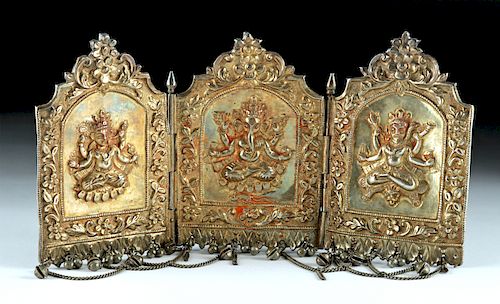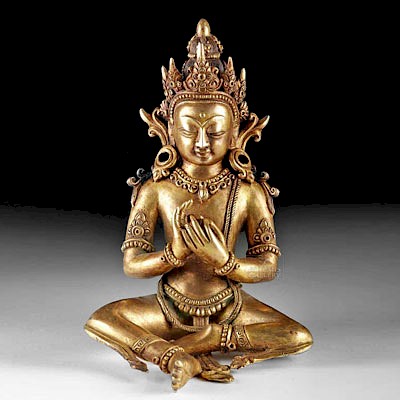Trifold 19th C. Indian Mukut Gilded Silver Headpiece
Lot 88d
About Seller
Artemis Fine Arts
686 S Taylor Ave, Ste 106
Louisville, CO 80027
United States
Selling antiquities, ancient and ethnographic art online since 1993, Artemis Gallery specializes in Classical Antiquities (Egyptian, Greek, Roman, Near Eastern), Asian, Pre-Columbian, African / Tribal / Oceanographic art. Our extensive inventory includes pottery, stone, metal, wood, glass and textil...Read more
Categories
Estimate:
$3,000 - $4,500
Absentee vs Live bid
Two ways to bid:
- Leave a max absentee bid and the platform will bid on your behalf up to your maximum bid during the live auction.
- Bid live during the auction and your bids will be submitted real-time to the auctioneer.
Bid Increments
| Price | Bid Increment |
|---|---|
| $0 | $25 |
| $300 | $50 |
| $1,000 | $100 |
| $2,000 | $250 |
| $5,000 | $500 |
| $10,000 | $1,000 |
| $20,000 | $2,500 |
| $50,000 | $5,000 |
| $100,000 | $10,000 |
| $200,000 | $20,000 |
About Auction
By Artemis Fine Arts
Jun 6, 2019
Set Reminder
2019-06-06 10:00:00
2019-06-06 10:00:00
America/New_York
Bidsquare
Bidsquare : VARIETY AUCTION | Ancient & Ethnographic
https://www.bidsquare.com/auctions/artemis-gallery/variety-auction-ancient-ethnographic-4182
Around the world & back in time - be amazed at the treasures you will find. Antiquities from Egypt, Greece, Italy and the Near East, Asian, Pre-Columbian, African / Tribal / Oceanic, Native American, Spanish Colonial, Russian Icons, Fine Art, much more! All categories, all price ranges...all legal Artemis Fine Arts info@artemisfinearts.com
Around the world & back in time - be amazed at the treasures you will find. Antiquities from Egypt, Greece, Italy and the Near East, Asian, Pre-Columbian, African / Tribal / Oceanic, Native American, Spanish Colonial, Russian Icons, Fine Art, much more! All categories, all price ranges...all legal Artemis Fine Arts info@artemisfinearts.com
- Lot Description
South Asia, India, Mukut, ca. late 19th to early 20th century CE. Truly stunning, a gilded silver headpiece comprised of three elaborate panels that are decorated in repousse with Hindu deities (Ganesha in the center panel flanked by his parents Shiva and Parvati), a beaded and floral border that crests above, and a leaf-like lower border below. Bells and swags of chain are suspended below, and the three panels are joined via hinges so that the piece can be repositioned. The gilded silver is of a very high grade (98.5% silver gilded with 1.5% gold) and the surface also shows attractive traces of red cinnabar. Size: 10.25" W x 5" H (26 cm x 12.7 cm) - 6.75" H (17.1 cm) including suspended bells and chains
Esteemed as one of the principle deities of the Hindu pantheon, the first son of Shiva and Parvati, Ganesha is known as the Lord of Plenty or the God of Auspiciousness, highly revered as the regulator of all obstacles with the power to create and remove them. Followers traditionally ask for his blessings at the beginning of any new paths or serious endeavors. The origin of his unusual physiognomy, particularly how he came to possess such an unusual head is the source of many legends, the most popular is that one day when Shiva was away from home, Parvati created a human son from her own body. She asked her son to guard the door while she was bathing. Quite unexpectedly, Shiva returned home, and the boy would not allow Shiva to enter his own household. Enraged by this, Shiva cut off the boy's head. Parvati grew quite angry and ordered Shiva to replace his head. Shiva did so with the first living being he encountered, an elephant.
Ganesha is widely revered as the remover of obstacles, the patron of arts and sciences, and the deva of intellect and wisdom. As the god of beginnings, he is honored at the start of rituals and ceremonies. Ganesha is also invoked as patron of letters and learning during writing sessions. Ganesha's image is found throughout India. Hindu sects worship him regardless of affiliations. Devotion to Ganesha is widely diffused and extends to Jains, Buddhists, as well as beyond India.
Provenance: private House of Indus collection
All items legal to buy/sell under U.S. Statute covering cultural patrimony Code 2600, CHAPTER 14, and are guaranteed to be as described or your money back.
A Certificate of Authenticity will accompany all winning bids.
We ship worldwide and handle all shipping in-house for your convenience.
#138174Expected wear commensurate with age. Some missing bells below and a couple of breaks to the chain swag which could probably be easily repaired. Behind the crested forms of each panel are cylindrical receptacles that likely once held further adornments.Condition
- Shipping Info
-
All shipping is handled in-house for your convenience. Your invoice from Artemis Gallery will include shipping calculation instructions. If in doubt, please inquire BEFORE bidding for estimated shipping costs for individual items.
-
- Buyer's Premium



 EUR
EUR CAD
CAD AUD
AUD GBP
GBP MXN
MXN HKD
HKD CNY
CNY MYR
MYR SEK
SEK SGD
SGD CHF
CHF THB
THB














